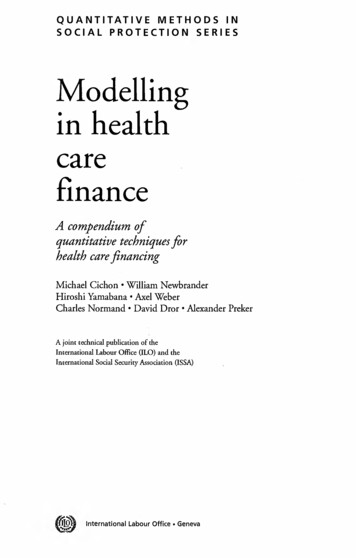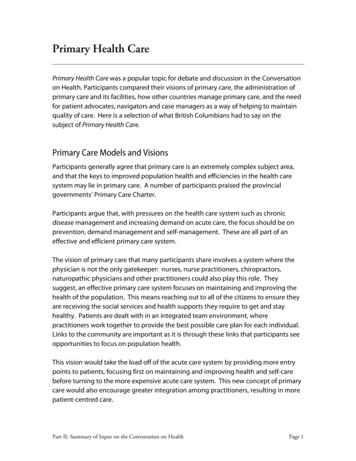
Transcription
QUANTITATIVE METHODS INSOCIAL PROTECTION SERIESModellingin healthcarefinanceA compendium ofquantitative techniques forhealth care financingMichael Cichon William NewbranderHiroshi Yamabana Axel WeberCharles Normand David Dror Alexander PrekerA joint technical publication of theInternational Labour Office (ILO) and theInternational Social Security Association (ISSA), . International Labour Office Geneva
Copyright International Labour Organization 1999First published 1999Publications of the International Labour Oifice enjoy copyright under Protocol 2 of the Universal CopyrightConvention. Nevertheless, short excerpts from them may be reproduced without authorization, on conditionthat the source is indicated. For rights of reproduction or translation, application should be made to thePublications Bureau (Rights and Permissions), International Labour Office, CH-1211 Geneva 22, Switzerland.The International Labour Office welcomes such applications.Libraries, institutions and other users registered in the United Kingdom with the Copyright Licensing Agency,90 Tottenham Court Road, London WIP OLP (Fax: 44 171 631 5500), in the United States with the CopyrightClearance Center, 222 Rosewood Drive, Danvers, MA 01923 (Fax: 1 978 750 4470), or in other countries withassociated Reproduction Rights Organizations, may make photocopies in accordance with the licences issued tothem for this purpose.Michael Cichon, William Newbrander, Hiroshi Yamabana, Axel Weber, Charles Normand, David Dror,Alexander PrekerModelling in health care finance: A compendium of quantitative techniques for health care financingGeneva, International Labour Office, 1999/Medical care/, /health insurance/, /fmancing/, /social security financing/,/ model/,/simulation/,/developed country/,/developmg country/. 02.07.6ISBN 92-2-110862-7ILO Cataloguing-in-Publication dataThe designations employed in ILO publications, which are in conformity with United Nations practice, and thepresentation of material therein do not imply the expression of any opinion whatsoever on the part of theInternational Labour Office concerning the legal status of any country, area or territory or of its authorities, orconcerning the delimitation of its frontiers.The responsibility for opinions expressed in signed articles, studies and other contributions rests solely with theirauthors, and publication does not constitute an endorsement by the International Labour Office of the opinionsexpressed in them.Reference to names of firms and commercial products and processes does not imply their endorsement by theInternational Labour Office, and any failure to mention a particular firm, commercial product or process is nota sign of disapproval.ILO publications can be obtained through major booksellers or ILO local offices in many countries, or direct fromILO Publications, International Labour Office, CH-1211 Geneva 22, Switzerland. Catalogues or lists of newpublications are available free of charge from the above address.Printed in the United KingdomALD
To all our friends and colleagueswho work to keep national healthsystems affordable for all in needThe authorsJuly 1999
FOREWORDQuantitative health care analysts around the world must constantly respond tothe queries of health policy makers. These days, their main question is 'howmuch?'. They may ask for information that is relatively simple and straightforward - the financing provisions of existing schemes, for example. At the otherend of the spectrum, they may ask for complex analyses - for example, regarding possible future scenarios. Some typical questions from policy makersinclude: What would be the aggregate cost of an increase in doctors' fees by amount x?What would we save if we were to increase co-payments by amount y?How much does the existing system cost?Can we afford to introduce a national health insurance scheme? Ifso, how wouldit affect the health care financing liabilities of the government, employers andemployees?Who bears the cost at present, and how can the financial burden be reallocated?This book will help analysts to answer these questions. Answers can only bederived from simpler images of complex reahties - i.e. from financial models ofnational health care systems. The book offers instruction on how to build suchmodels. In order to do so, analysts need to have at least a grounding in macroeconomics, health economics, health policy, financial planning and management,as well as actuarial techniques. This is a tall order for any one person. Withoutsuch knowledge, analysts run the risk of using ad hoc methodologies, whichoften breed uneasiness about the capacity to deal with the problems at hand.Lessons from the field experience of the ILO and other organizations arebrought together in this book. Quantitative work in many countries is oftendone in an uncertain policy environment, with deficient data, and usuallyunder a variety of other constraints.-. The approach to the subject of this book is pragmatic and output-oriented,offering a guideline for the busy professional. The book attempts to createvii
Forewordsynergies and bridge gaps between quantitative health economics, health financingand actuarial science. Field practice will put the techniques mentioned here to thetest. It is intended for planners and managers in charge of national health carefinancing systems, as well as specialists in international technical cooperation.Theoretical, actuarial and health-related economic concepts are translatedinto pragmatic tools for short- to medium-term financial planning, managementand monitoring. This book also follows up on a previous guidebook on healthinsurance published by the WHO and the ILO.1 We hope that it will prove to bea practical guide to financial modelling for the specialist, as well as a referencefor modelling methodology.This volume is part of a series on quantitative techniques in social protectionbeing published by the Financial, Actuarial and Statistical Branch of the SocialSecurity Department of the ILO, together with the International Social SecurityAssociation. Other volumes in this series are:Actuarial mathematics of social security pensionsActuarial theory of social security pension schemesActuarial practice in social security pension schemesSocial budgetingThese monographs are all scheduled to be published over the next twoyears. The objective of this series is to provide a full set of compendiums onthe quantitative analysis of national social protection schemes. It is alsohoped that they will find their way into university and professional trainingcourses, where training materials on these issues are notoriously scarce.Future ILO and ISSA training courses on quantitative techniques in socialsecurity issues will also use these manuals as required reading.The Financial, Statistical and Actuarial Department welcomes your comments and feedback on the book in general, on your experience with the useof the modelling techniques described here, and on their adaptation to thespecific situations found in your country or scheme.Colin GillionDirectorSocial Security DepartmentInternational Labour OfficeGeneva, Switzerland1Dalmer D. HoskinsSecretary GeneralInternational Social Security AssociationGeneva, SwitzerlandWHO and ILO, Social health insurance: A guidebook for planning, Geneva: WHO, 1994.
CONTENTSForewordviiAcknowledgementsXVAbout the authorsPart I The context of modellingxvii11 Introduction1.1 Background1.2 Modelling1.3 Objectives and audience1.4 The structure of this book2 Scope and focus2.1 Modelling in health care financing: Focus, context and process2.2 The dual processes of health policy design and modelling2.3 Model limitations and the learning process2.4 Summary3 The modelling object3.1 The economics and economic environment of the health sector3.2 National health care financing systems3.3 Public health care financing systems3.4 Summary3356710102231323435374168Part II Model building714 Databases4.1 Health accounting4.2 Health statistics4.3 Core statistical data and data sources for financial modelling4.4 Data handling for modellers4.5 Summary737483878994ix
Contents5 The modelling process5.1 The six steps of the modelling process5.2 Methodological philosophy and principles: Six ground rules5.3 A typical model design5.4 Summary6 Calculation techniques6.1 A standard population projection method6.2 Key projection factors6.3 Income projections6.4 Projecting expenditure6.5 Plausibihty controls6.6 Calculation of a medium-term contribution rate6.7 A pragmatic, stochastic extension of the modelling approach6.8 Summary7 Model examples7.1 The actuarial model of Management Sciences for Health (MSH)7.2 The WHO model for local governments7.3 The WHO budget model for ministries of health (SimFin)7.4 The model of the Australian Health Insurance Commission7.5 The Japanese Ministry of Health social health insurance model7.6 The stochastic model of the German Ministry of Labour7.7 Some ILO models7.8 165170174176179182184207Part III Using models in policy decisions2098 Policy decisions8.1 What are the most critical health needs?8.2 How can a health system provide effective and efficient services?8.3 How can countries finance their health systems?8.4 What is the appropriate mix of the public and private sectors in thedelivery and financing of health care?8.5 Summary9 ConclusionIssue brief 1: Concepts of health economics1.1 Health and health gains as crucial products of the health care sector1.2 The nature of the health care market1.3 Demand for health care goods and services1.4 Supply of health care goods and services1.5 Market characteristics and the financing of health care: An economicdiscussionIssue brief 2: Financial management and accounting for health schemes2.1 Basics for the management of insurance scheme finances2.2 The importance of financial 44244245
Contents2.3 The financial management cycle2.4 Budget formulation2.5 An accounting framework for a national health insurance scheme2.6 MonitoringIssue brief 3: A primer on the mathematics of private health insurance3.1 The characteristics of private health insurance3.2 Calculation of the risk premium (RP)3.3 Calculation of the net constant individual premium (CIP)3.4 Calculation of the annual gross premium3.5 Reserve calculations3.6 The influence of change in the basic variablesIssue brief 4: Regression analysis4.1 Linear regression (for one independent variable)4.2 Multiple regression analysis4.3 Example: Estimating the utilization of physician servicesAnnex: International reference statisticsA. Global health statistics: Basic indicatorsB. Ten country esNotes: E Example (e.g. Table E2.1 is found in Example 2.1, in Chapter 2)B Box (e.g. Table B3.1 is found in Box 3.1, in Chapter 3)IB Issue Brief (e.g. Table IB2.1 is found in Issue Brief .15.15.2Cost estimate for the coverage of pharmaceuticals in outpatient careSHI Demoland: Status quo projectionSHI Demoland: New benefit simulationSHI Demoland: Effect of new benefit on national social budgetFinancing of health systems in the OECD, early 1990sNational social health insurance modelsPure payment methods and their applicationIncentive structure of payment mechanismsICHE-HA functional classification of medical careICHE-HP classification of providers of medical careICHE-HF classification of medical care financingThe hierarchy of health statisticsAn aggregated national health income and expenditure statementMatrix representation of a national health care budget15232424414557627980818599100xi
7.177.187.197.20IB2.1IB2.2IB4.1xiiA typical data list for a national health budget modelThe core contents of the legal description of the schemeA possible disaggregation of the insured populationCommon forms of co-payments and their usual useVariables and projection parameters in a social insurance modelApplying the 12 equationsIncome distribution of individuals in Demoland, 1998Sensitivity testing and the effect of income ceilingsObserved and approximated values of the J-curve for a utilizationindicatorCalculation of the constant contribution rateContribution rate calculation, MSH modelPopulation, health insurance membership and care cases in Hai Phong,Viet NamFinancial results of model for the health insurance scheme in HaiPhong, Viet NamSummary of expenditure by type of service, Turkish health care systemSummary of expenditure by source of funds, Turkish health caresystemFinancial effects of 1997 amendments to the Employees' HealthInsurance scheme in JapanFinancial projections for the Employees' Health Insurance scheme inJapanProjected contribution rates for the Statutory Health Insurance Systemin the Federal Republic of Germany, 1981-1985Estimated fund operation in short-term benefits, 1996-2007Assumptions for health care financing and social budget projection forUkraine, 1995-2015Ukraine's social budget as a percentage of GDPHealth care parameters and assumptions for the Ukrainian exerciseProjections for the government health care delivery system in UkraineHealth care projections: Results of the Ukrainian exerciseCalculation of contribution base (in Euroland currency units)Per capita costs in Euroland currency units (CU), 1997Total health costs in Euroland CUsConsolidated income and expenditure forecastCosts shared through co-paymentsSimulating alternative policy options in EurolandSystems of financial accountingSample components for annual reportsData for multiple regression 0261282
ContentsFiguresNotes: B Box (e.g. Figure B2.1 is found in Box 2.1, in Chapter 2)IB Issue Brief (e.g. Figure IB2.1 is found in Issue Brief 6.1bB6.47.17.27.37.47.57.6IB2.1IB4.1A roadmap through this book, or What this book doesThree basic transformations in national health sectors and the scope offinancial modelsIncome levels and life expectancyThe financial equilibrium of a health care financing scheme and itsdetermining factorsThe hierarchy of models and accounts in social protection and healthcareAlgorithm of critical decisions in policy designHealth expenditure as a share of GDP and per capita GDP in60 countries in the mid-1990sCategories of health care financing systemsThe bipolar structure of a public health service systemThe structure of a social insurance health care finance and deliverysystemExpected macroeconomic effects of rising health care costs under a socialhealth insurance schemeThe flow of data in the pluralistic health care system of the FederalRepublic of GermanyA standard flow chart for a financial model of a health care schemeThe log-normal distribution of mean 10,000 and standard deviation4,000Income distributionThe J-curve and its proxyThe sustainability of health insuranceValuation results under partial premium payment complianceValuation results under full premium payment complianceProjected and real development of contribution rates in the FederalRepublic of GermanyContribution rates under alternative policy optionsDevelopment of reserves and deficits under alternative policy optionsSummary of the accounting processResult of sample 9170184206206256284
ACKNOWLEDGEMENTSThis book is the result of a team effort by a number of people who have madesubstantial contributions:Jose TossaDiane VergnaudCompiled the statistical annex.Kenichi HiroseProvided descriptions of the social security modelin Thailand and the methodology of the ILOpopulation model.Janet NeedhamPrepared papers for the ILO some years ago,upon which the accounting section of the bookdrew.Guy CarrinContributed the description of the latest WHOmodel, SimFin, which simulates financial needs andgovernment budget options for the health system.David CollinsChecked on our write-up of accounting principlesin health care schemes.Theodore FisherUndertook the first round of comprehensiveediting and lay-out work, and made this volumereadable. He also prepared the index.Colin GillionRobert FontaneauXenia Scheil-AdlungProvided us with annoyingly critical butconstructive comments on successive draftversions.Guy CarrinAndrew CreeseJosep FiguerasColin GillionWarren McGillivrayXenia Scheil-AdlungServed as final reviewers of the book. Theircomments provided us with a very important finalquality control.
AcknowledgementsKaruna PalAssisted with editing and performed the final checkPatricia Frenetteof the layout.The PublicationsShepherded this book through the internal andBureau of the ILOexternal publication process.Our sincerest thanks to them all.The authorsBoston, Cologne, Geneva, London and WashingtonSummer 1998
ABOUT THE AUTHORSMichael Cichon holds a Masters degree in Pure and Applied Mathematics (Technical University, Aachen, Germany), a Master of Public Administration degree(Harvard University) and a Ph.D. in health economics (University of Goettingen). He is a member of the German Actuarial Association (DAV), andworked in the Planning Department of the German Ministry of Labour andSocial Affairs in Bonn as an actuary for eight years before joining the SocialSecurity Department of the ILO in 1986 as senior actuary and health economist.Between 1992 and 1995, he served as the social security specialist on the ILOadvisory team for Central and Eastern Europe in Budapest. In 1995, he wasappointed Chief of the Financial, Actuarial and Statistical Branch of the ILO'sSocial Security Department. He writes on financial and economic issues relatedto social security, with occasional excursions into governance. He has undertakentechnical cooperation assignments in more than 15 ILO member countries.David M. Dror trained in economics and business administration. He becameinvolved in social security issues when he served as Director of the LaborRelations Department in the Israeli Employers' Federation. He has elaboratedand negotiated a nationwide pension agreement, developed innovative solutionsfor COLA wage indexation during periods of hyperinflation, and served as leadrepresentative on the Council of the National Insurance Institute of Israel. Hewas appointed to the ILO Committee of Experts on Social Security Questions,and was involved in the elaboration of social security standards during the yearshe served as Delegate to the International Labour Conference. As an ILOofficial, he first dealt with the issue of the investment of social security funds;later on, he was the Chief of the ILO-ITU Staff Health Insurance Fund for anumber of years. He now serves as senior specialist for health questionswithin the Social Security Department.William Newbrander is a health economist and Director of the Health Reformand Financing Program of Management Sciences for Health (MSH) in Boston.xvii
About the authorsPrior to joining MSH, he worked with the WHO for eight years, both ashealth economist at their Geneva headquarters, and as Program ManagementOfficer and Acting WHO Representative in Thailand and Papua NewGuinea. He has served as a hospital administrator in the United States andother countries. He has authored numerous journal articles and severalbooks, including Private Health Sector Growth in Asia: Issues and Implications;and Decentralization in a Developing Country: The Experience of PapuaNew Guinea and Its Health Service; as well as the WHO document HospitalEconomics and Financing in Developing Countries. He received his Ph.D. inHealth Economics and also earned a Masters of Hospital Administration andMasters of Applied Economics from the University of Michigan.Charles Normand trained in economics at the Universities of Stirling and York(UK). He became interested in health economics and financing when working asprincipal economist for health and social services in Northern Ireland. Since1991, he has been Professor of Health Policy at the London School of Hygieneand Tropical Medicine, and was head of the Department of Public Health andPolicy from 1993 to 1998. At the School, he teaches health economics and healthsector management. He has carried out research and advisory work on healthcare financing in many of the countries of Central and Eastern Europe,Ghana, Zimbabwe and South Africa. He co-authored the WHO/ILO Guidebook for Planning with Axel Weber. His other research interests are mainly inhealth technology assessment, modelling outcomes and cost-effectiveness, andhuman resources in health care.Alexander S. Preker is currently Lead Economist for the Health, Nutrition, andPopulation (HNP) sector of the World Bank. He is responsible for overseeing theBank's policy development, analytical work, and staff development relating tohealth care financing and delivery systems. He coordinated the Bank team thatprepared the recent HNP Sector Strategy Paper, and is now heading a teamthat is examining methods of harnessing private-sector resources to meet broaderhealth care objectives in low- and middle-income countries. Recent publicationsinclude: World Bank Sector Strategy: Health, Nutrition, and Population; HealthCare for an Aging Population: Issues and Options; Health Status during the Transition in Central and Eastern Europe: Development in Reverse; Balancing Competitionand Solidarity in Health Care Financing; Health Care, Labor Markets and SocialPolicy in Central and Eastern Europe; and Meeting the Challenge: Policymakingand Management during Economic Transition. He also contributed to the followingpublications: 1993 World Development Report: Investing in Health; EuropeanHealth Care Reforms: Analysis of Current Strategies; and Investing in Peopleand Growth. He received a Ph.D. in economics from the London School ofEconomics and Political Science, a Fellowship in Medicine from UniversityCollege London, a Diploma in Medical Law and Ethics from King's CollegeLondon, and an MD from University of British Columbia/McGill.
About the authorsAxel Weber is an economist specializing in social protection and healthcare financing. He studied in Cologne (Germany) and at Pennsylvania StateUniversity (USA). He has worked for the German Ministry of Labour, theFederation of the German Sickness Funds and the European Commission.Currently, he is working as a freelance consultant for the ILO, WHO, theWorld Bank and bilateral aid agencies. He has experience on assignments inall regions of the world.Hiroshi Yamabana is an actuary in the Financial, Actuarial and StatisticalBranch (SEC/FAS) of the Social Security Department of the ILO. He studiedmathematics at Kyoto University (Japan) and worked as an actuary for theJapanese Ministry of Health and Welfare for five years. His experience at theMinistry included establishing the National Pension Fund, periodical actuarialvaluations of the National Pension Scheme (NP) and the Employees' PensionInsurance Scheme (EPI), and the integration of industry-specific pensionschemes (e.g. for Japan Railway) into the EPI. He is currently working onactuarial valuations of social security schemes in developing countries and thedevelopment of actuarial methodologies and techniques in social security.xix
PARTITHE CONTEXT OF MODELLING
INTRODUCTION1Health care systems are a prominent focus for national leaders and policymakers in most countries today. This fact reflects concerns about the availability of necessary health services for the population, as well as about theefficiency and costs of current health systems in delivering those services.The degree of importance of this issue in any given country is directly relatedto the size of the health care system relative to the national economy. Nearlyall decisions of policy makers about national health systems must be based onthe quantitative aspects of the options available, and the impact of anydecisions taken. A quantitative description of the current health system andprojection of the impact of changes to the system through new policyinitiatives is also critical to reform. Hence, the ability to quantitativelydescribe health systems as well as to create a range of "what if" scenariosbased on new directions for those systems is increasingly important in allcountries.The objective of this book is to help those who do the quantitative work thatserves as a background for policy decisions to present reasoned projectionswhich will, in turn, facilitate the creation of informed policies. Those calledupon to map the current state of health systems, to simulate financial outcomesof proposed changes to existing health systems, or to predict the future underdifferent scenarios will need to use mathematical modelling techniques. Thisbook is concerned with describing the context and techniques for developingquantitative descriptions and projections through modelling. It provides thetools to build models of health care financing systems.1.1BACKGROUNDThe main objective of a health care delivery system is to maintain or improvethe health status of the population. This is accomplished mainly by preventingdisease and illness - or in the case of illness, by providing curative and rehabilitative care. These objectives should be carried out as efficiently as possible, and
Modelling in health care financeat costs that are both bearable for the participants and financially sustainablefor society.A social or national health care system would also aim to guarantee access tohealth services for the entire population, regardless of individual ability to pay.Many national health care systems in Africa, Asia, Europe, Latin America andNorth America may be regarded as successful because of their extent of accessto care, and the high quality of that care. However, many schemes in the developing world do not yet provide adequate physical or financial access to qualityhealth services for the entire population. In the past two decades, the cost ofhealth care systems has become an increasing concern for governments in developed as well as developing countries. In the past, rapid real economic growthoften made it possible to increase both the level of access to and quality ofcare. This was the case, for example, in the postwar period of most OECDcountries. However, since the mid-1970s and the economic crises of the 1980sand 1990s, evidenced in the dramatic reductions in GDP growth rates, theemphasis in many countries has shifted from expanding services and improvingquality to attempting simply to maintain the level of existing services. Thus, thesustainability and cost containment efforts of health systems have become themajor challenges, and financing is a critical element in meeting these challenges.The emphasis in health care financing today has shifted to cost containmentthrough efficiency gains in existing systems, while finding effective mechanismsfor funding the overall health system in a long-term, sustainable fashion. Forless affluent countries of the world, the pressure to reform their health systemsand financing mechanisms has become even more acute.Demand for health services continues to rise. While some of the increasemay be attributable to population growth and changing disease patterns,demand has also been created through such factors as new technologies to diagnose and cure illnesses. These technologies are generally more costly than existing ones, and often represent only a slight marginal benefit in terms of healthoutcomes relative to increased costs. While consumers demonstrate a considerable tolerance for rising health care prices, collectively financed health care systems are increasingly sensitive to the rising costs of health care. The ultimateconsequence of unrestrained cost increases may be a rationing mechanism forthe distribution of health services. Simply allowing the health care marketand prices to perform this rationing function creates ethical concerns and provokes debate about the equity of the system. This ongoing debate in manynational systems reflects the fact that interactions between three key factorsare not fully understood: the objective need for health goods and services, thedemand for those goods and services, and the development of benefit entitlements under the health care financing system. The relationship between theuse or consumption of health services and health outcomes is also not wellunderstood, especially since stochastic biological processes make this relationship difficult to determine. In short, uncertainty is a major characteristic ofthe health sector.
IntroductionIn order to provide affordable, accessible and effective health services tothose of the population in real need, resources must be targeted at the mostcost-effective interventions. This is accomplished primarily through the effectiveallocation and efficient use of existing resources, through such means as utilization and cost control. For the health care delivery system to be financially sustainable, sound resource allocation, financial governance, and monitoring ofhealth outcomes are necessary, regardless of whether the system is primarilypublic, private or mixed.1.2MODELLINGQuantitative tools are needed for sound resource allocation and financial governance of health systems. These are of two primary types: descriptive tools andanalytical tools. Descriptive tools are standard instruments for sound governance, and consist of financial reporting and controls in the form of accountsand statistics. Analytical tools allow policy makers to perform status quo mapping, which is used to assess the financial development of existing systems, underthe assumption that present regulatory or managerial frameworks are maintained. The "map" of the s
4.3 Core statistical data and data sources for financial modelling 87 4.4 Data handling for modellers 89 4.5 Summary 94 ix . Contents 5 The modelling process 97 5.1 The six steps of the modelling process 97 5.2 Methodological philosophy and principles










